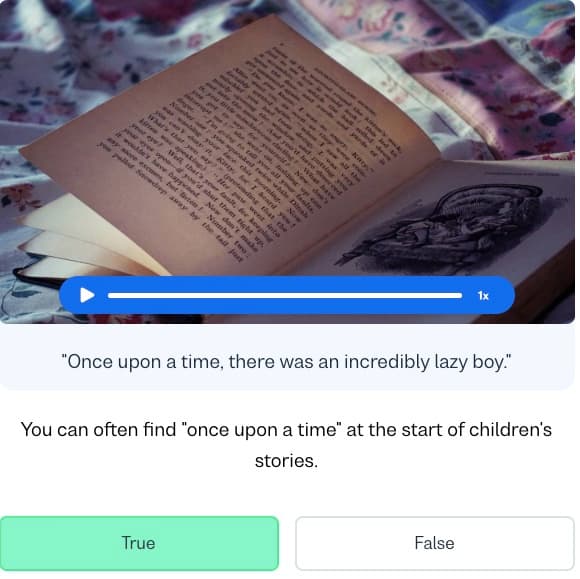Importance of Storytelling in Language Learning
Discover the power of storytelling in language learning and get 6 ways to use it to boost your language skills.
Author:

Barney Meekin
What’s the first thing that comes to mind when you think about learning a language? There’s a good chance that you think of vocabulary flashcards, grammar rules, or pronunciation drills. Sure, these are important and effective. But they’re not the most interesting.
Our experiences learning languages at school define what learning a language is to us. I remember sitting in German class as a 14-year-old. I remember doing lots of doodling as the teacher — at length — explained vocabulary and grammar rules. And I remember almost no German now. The teacher tried his best but that experience put me off learning a language for almost a decade.
When you focus on vocabulary, grammar, and pronunciation, you miss out on an activity that is deeply meaningful to humans (and great for learning a language): Storytelling.
Storytelling is a part of our history and culture. But we don’t make the connection between it and learning a language. This is a huge shame because storytelling is a fantastic way to learn a language.
In this article, you’ll learn all about why storytelling is great for learning and how you can use it to master a new language.
What is storytelling in language learning?
In language learning, storytelling is listening to, reading, or telling your own stories in your new language. You can consume stories or you can create them. Either way, storytelling is beneficial for your language learning (and it’s fun).
The types of storytelling
Stories come in many different shapes and forms. Let’s take a look at the different types of storytelling you can use in your language learning.
Written storytelling
Novels, poems, short stories, journalism, and non-fiction books are some of the most popular examples of written storytelling. People love to read stories. Traditionally in books or newspapers, but nowadays online too.
Oral storytelling
Every culture has traditional stories, folktales passed down through the generations. These are examples of oral storytelling. The jokes people crack are storytelling too.
Performance arts
People tell stories through performance arts like dance, music, opera, stand-up comedy, and theater.
Visual storytelling
You can also tell stories through photography, video, animation, infographics, and illustrations. Comics and TV shows, for example, are popular examples of visual storytelling.
Digital storytelling
Nowadays we can use computers to tell stories — we can integrate text, audio, video, images, maps, and social media into one often interactive story. This is digital storytelling. A famous example of digital storytelling is Snow Fall by John Branch for the New York Times. It includes text, images, video, and interactive elements.
Why is storytelling important for language learning?
Let’s take a look at why storytelling can help you master a language.
Context
Understanding individual words’ meanings is great. But encountering those words in a story gives you a more vivid context. This context makes language elements stick in your memory.
Cultural background
Culture is an important part of learning a language. Through tales of festivals, traditions, and everyday life, stories teach you the cultural nuances that are hard to learn through traditional language study.
Memory
When you encounter a new word in an interesting story, you're more likely to remember them.
Motivation
Stories are enjoyable. Sometimes they’re so exciting you can’t put the book down (or turn the TV off). Having fun is one of the best ways to maintain your motivation for learning a language. You can use storytelling to maintain your interest in a language.
Storytelling benefits: What the research says
You don’t need to take my word for it. There’s a lot of research into storytelling in second language learning out there that shows the benefits. Let’s take a quick look at some.
Improves language skills
Storytelling includes several benefits for language learners. This meta-study found that storytelling is great for improving language skills. It encourages learners to be active in the language-learning process. It boosts motivation and increases willingness to interact in a second language. It also gives learners plenty of comprehensible input. That’s a lot of proven benefits of storytelling.
Creates a stress-free learning environment
Storytelling creates a low-anxiety environment in which you can learn new vocabulary and language structures. Anxiety is one of the hurdles many language learners struggle to overcome. Storytelling is a big help.
Improves 4 language skills
Storytelling is a great way to improve the four language skills: Reading, writing, listening, and speaking. Not many other language-learning methods hit all four of these at once.
Tips for learning language through storytelling
As you can see, storytelling has many benefits for language learners. Unlike many other language-learning methods it helps with both receptive and productive skills. This means whether you need to practice speaking or listening, writing or reading, you’ll benefit from it.
But as there are many kinds of storytelling, there are many ways to use it in your study too. It’s important to find the method that suits you and can help you achieve your goals.
Here’s a rundown of tips to help you make the most out of storytelling in your language learning.
1. Start simple
When you're getting started with storytelling, go for content that's easy to digest.
Children's tales, for example, use basic vocabulary and uncomplicated sentence structures. As you get better, you can confidently move on to content for young adults and then adults.
But what about if you don’t want to consume kids' content? (Totally understandable by the way). Well, some languages — English for example — have a wide range of graded resources for learners. For example, graded readers are simplified versions of stories. The great thing about this is that you can get hold of materials for adults that aren’t too difficult to understand.
2. Listen to audiobooks
Audiobooks give you a unique blend of listening and reading. You get all the benefits of listening to a story. But you can also listen to natural pronunciation. One of the great things about audiobooks is that you can follow along with the physical book too.
3. Create your own stories
Engage your creative side by coming up with your own stories. You get to use the language you’ve learned and your imagination in a fun activity. And to make it even more fun, nowadays we have access to tools that make visual and storytelling easy (more on those next).
4. Explore visual and digital storytelling
If you prefer visual media to written, visual storytelling is for you. Of course, you can consume visual stories everywhere nowadays. Just log in to YouTube or Netflix and you have everything you need. The images provide context, helping to clarify and solidify new vocabulary and phrases. But for a real challenge, try your hand at creating graphic novels, comic strips, animations, or illustrated stories.
You can also get involved in digital storytelling. These stories include a mixture of digital and interactive elements to tell stories. There’s a big overlap between these two. Netflix shows for example are both visual and digital storytelling. For a great example of what digital storytelling can be, check out Hollow, an interactive documentary.
5. Write a daily journal
Compared to the last section, this is pretty old school. But building a daily writing habit is a great way to support your learning. You can write anything in your journal — not only experiences and feelings. What matters most is the consistent practice of telling stories (real or fake). One important thing to remember when writing a journal is you don’t need to show anyone. This is only for you. These stories are not for sharing so be creative and don’t worry about making mistakes.
6. Share stories with peers
When you are ready and confident, share your stories. Getting feedback, starting discussions, and hearing other people’s stories all lead to meaningful learning experiences. Busuu's community of language learners and native speakers is a great platform for sharing and hearing stories.
Embrace storytelling for language learning gains
Storytelling is one of the most enjoyable ways to learn a language. There are countless stories out there for you to consume. And you also have the option of creating your own. Few other activities give you the opportunity to improve your receptive (reading and listening) and productive (speaking and writing) skills at the same time.
Stories should be a major part of your language learning. Find ways to use storytelling because it’s both fun and effective.
AUTHOR

Barney Meekin
Newlanguages


